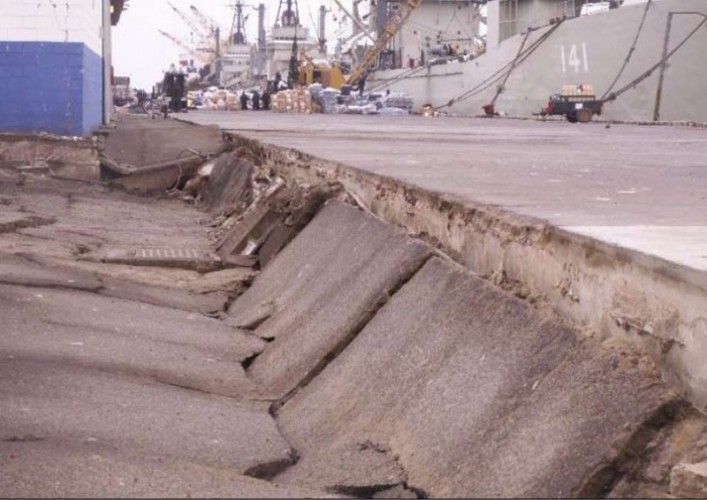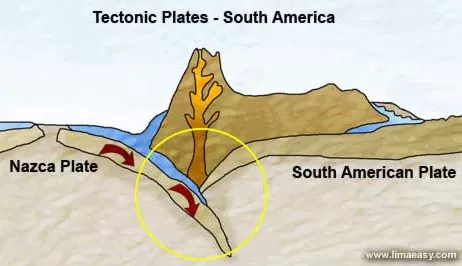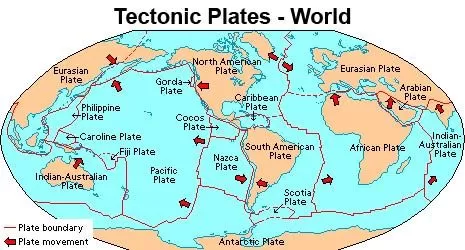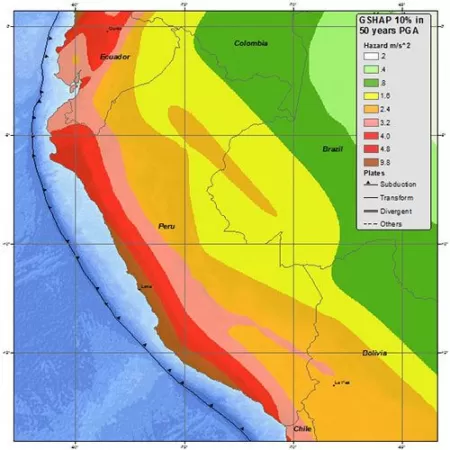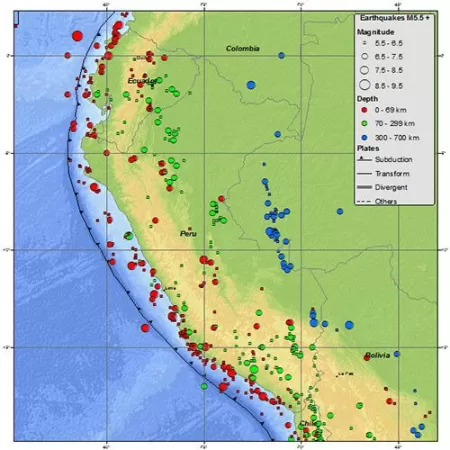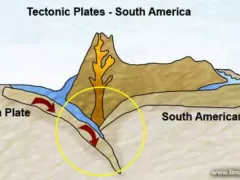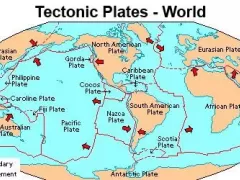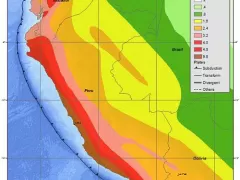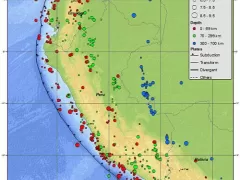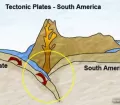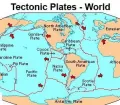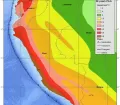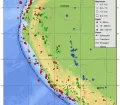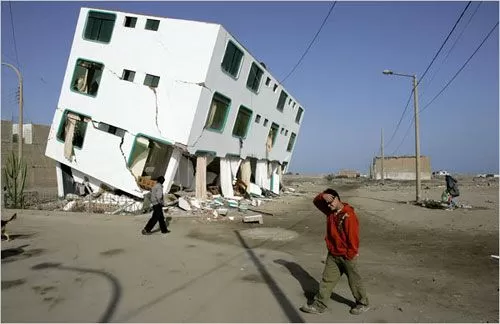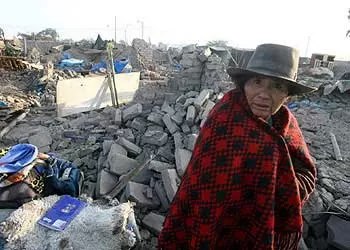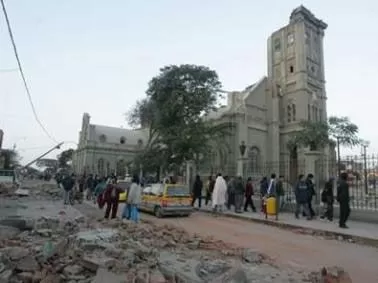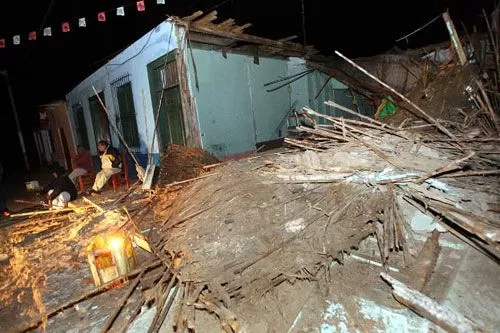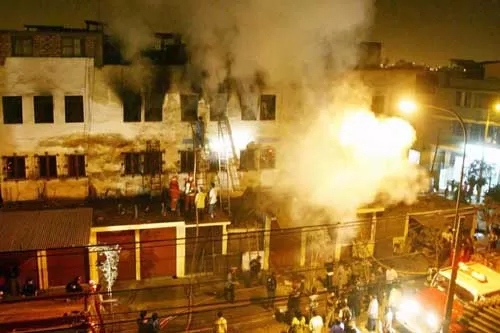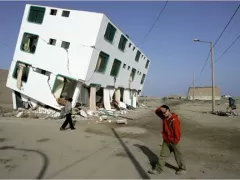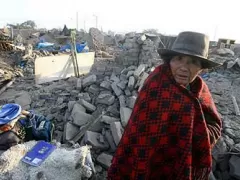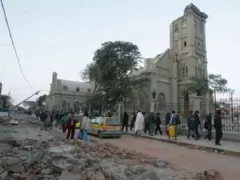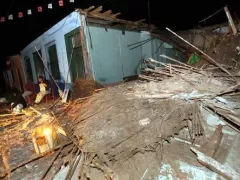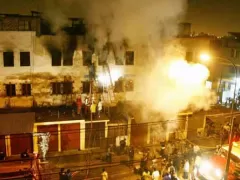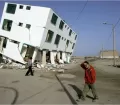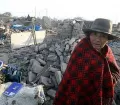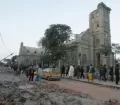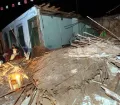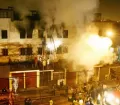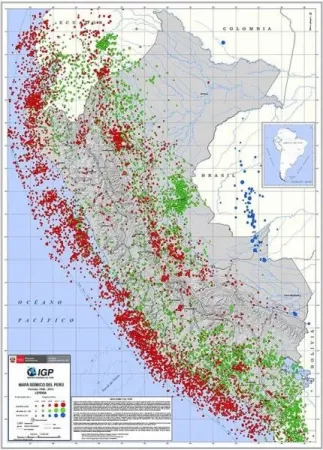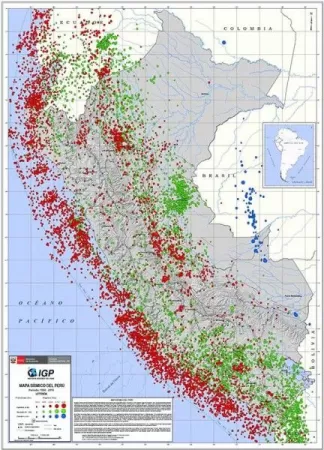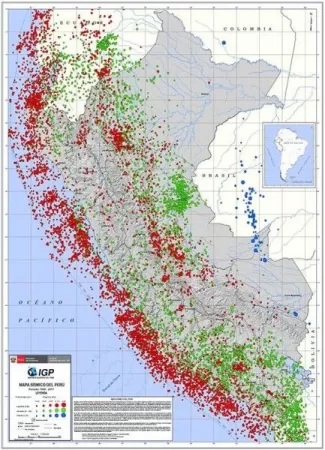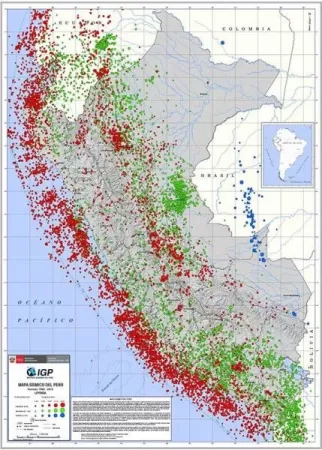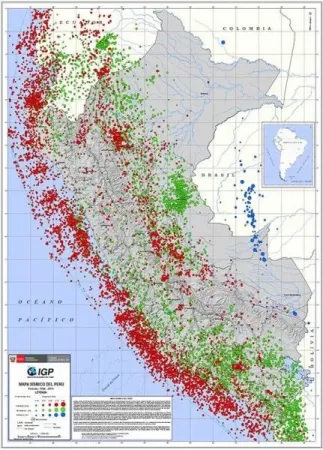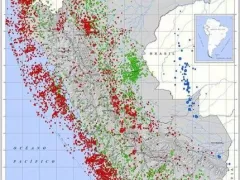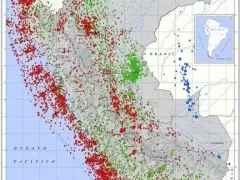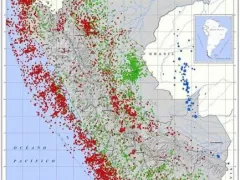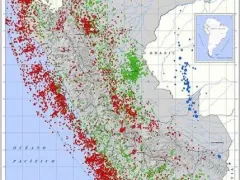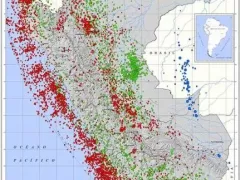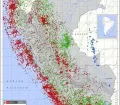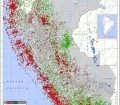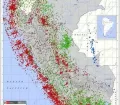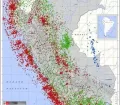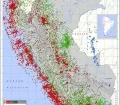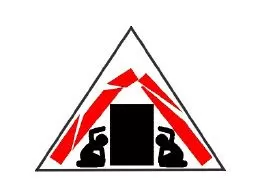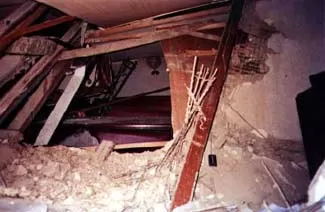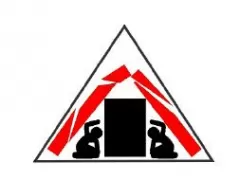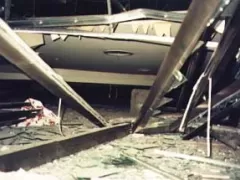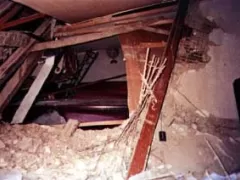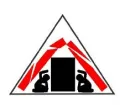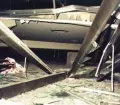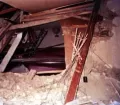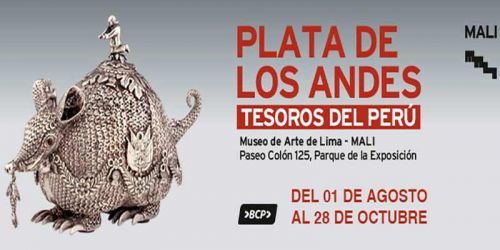Earthquakes are among the most powerful and terrifying events on earth. Unfortunately for thousands of years they have been a common occurrence in Peru. To this day we can't predict earthquakes and never know when and where to expect the next tremor and how bad it will be.
So, no matter if you are traveling in Peru or living here, the only option to get through a possible earthquake is to be prepared and know what to do before, during and after the shaking. Our explanations below hopefully will help with that.
Content Overview
- Why Earthquakes occur in Peru
- What happens during an Earthquake
- What to do before an Earthquake
- What to do during an Earthquake
- What to do after an Earthquake
Why Earthquakes occur in Peru?
Scientists have developed a theory, called plate tectonics, that explains why most earthquakes occur. According to this theory, earth's outer shell consists of about 10 large, rigid plates and about 20 smaller ones. Each plate has a section of earth's crust and a portion of thick layer of hot rock below the crust. The plates move slowly and continuously. They collide, move apart or slide past one another. These movements cause enormous tensions and subsequently earthquakes which relieve the stress.
Peru is situated along the boundary of two of these tectonic plates: the Nazca Plate and the South American Plate. These two plates "meet" off the Peruvian coast. The South American Plate is moving towards the Pacific Ocean over the Nazca Plate putting huge strain on the earth's crust. The pressures are periodically released through earthquakes.
The subduction of the Nazca Plate caused millions of years ago the rise of the Andes Mountains, the creation of the Peru-Chile Trench and the volcanism in the Peruvian highlands. Until today this process continues and causes a number of geo-dynamic processes.
The consequent results of a heavy earthquake striking the area are destruction, panic, fear, innocent casualties, poverty, hunger and diseases.
What happens during an Earthquake?
Many people, who have never experienced an earthquake, ask themselves how does it feel. The answer to that is diffcult. No earthquake is like another. An earthquake can be shallow, intermediate or deep; according to its and your location. Anyhow most earthquakes in Peru are prefaced by a strange and unfamiliar noise that gets under your skin. Before you realize what's going on you feel the ground shaking. Depending on different factors the shocks can be felt like a swinging movement or more like fierce and rapid strokes. The ground shaking can last a few seconds up to various minutes. Out of personal experience any second during such an event passes by like in slow motion and you think it's never going to end.
When you are inside a building you can feel a swaying from one side to another, an up and down bouncing, a wild vibration and / or a violent moving. All objects not fixed properly will do the same and follow every movement. Many people are injured by getting hit by loose household items. During a heavy earthquake buildings may contract or expand, be shaken apart, collapse or even slide of their foundation when they are too weak or rigid to resist the strong forces. If you realize this type of structural distress it will be wise to leave for a safer place outside before you experience the house coming down on you.
Well now comes the bad one: In cities like Lima for example being outside during an earthquake can be quite dangerous, too. Watch out for all kinds of falling objects, like bricks, glass, whole walls, street and traffic lights, signs, telephone posts, and so on. Beware of ruptured power lines, gas leaks and spilled fuels. A lot of households in Peru cook with gas (either natural gas lines connected to the house or domestic gas cylinders). The risks of erupting fires and explosions during and after an earthquake are high. Better look out where to smoke your relaxing cigarette ...
If you are enjoying a day at the beach when an earthquake strikes, better rush to higher grounds. An earthquake on the ocean floor can create a tremendous push to surrounding seawater and create destructive waves called tsunamis (also known as seismic sea waves). Tsunamis may build up to heights of more than 30 meters when they reach shallow water near the shore line. They can travel great distances in no time while diminishing little in size and can flood coastal areas in seconds without warning. In 1746 shortly after a heavy earthquake hit Lima, a devastating tsunami rolled over the port of Callao and completely destroyed what was left from the city. Thousands died. Even after the strong earthquake in 2007 south of Lima, coastal roads were badly flooded.
What to do before an Earthquake
An earthquake can never be predicted. There are no fixed pattern and no logic in where it hits and when. Because Peru lies in an active seismic zone the most important thing to do before the next tremor comes around is to be prepared.
Travelers unfortunately only can make sure that they know exactly what to do and how they should behave in case of an earthquake, which we explain in detail below under "What to do during an Earthquake?".
Those living in Peru can do much more and best should:
- learn about the earthquake plan of their neighborhood and workplace
- have a waterproof folder with your most important documents (originals of passports, birth / marriage certificates, insurance policies, deed / lease to home, medication list, etc.) and a bit of cash that is placed somewhere safe but can be easily grabbed when running out of your home
- have an emergency backpack for each person somewhere close to the door where you can easily grab it when running out or somewhere safe outside or in your car with the absolute necessities such as a bottle of water, change of clothes, necessary medication, small first aid kit, copies of your most important documents, small flashlight, multifunctional pocketknife, wet wipes, and perhaps a few crackers or similar
- if you think it’s necessary to prepare for a big one, pack a box with water (3.5l or a gallon per person for drinking and hygiene per day for several days), non-perishable food items (enough to last at least 3 days), plastic sheeting, duct tape, blanket, spoon / fork /knife, large first aid kit, battery-powered or hand crank radio, flashlight incl. batteries, sanitation and personal hygiene items, medication, copies of most important documents, some cash and don’t forget your pets. Place it close to a door or window so that it hopefully is still easily accessible after the quake without having to enter your home (yes, I know, difficult if you live on the 12th floor) or somewhere safe outside
- make up a plan where your family meets after an earthquake and don’t forget to involve your kids, so they know exactly for example to wait at school until mum or dad pick them up.
- make your home “earthquake-safe”: don't leave heavy objects on shelves (they'll fall during a quake) and anchor heavy furniture, cupboards, and appliances to the walls or floor.
- have a fire extinguisher, first aid kit, a battery-powered radio, a flashlight, and extra batteries at an easily and quickly accessible place at home
- make sure you know where to turn off the gas, water and electricity in your home
Maps of all earthquakes in Peru 2015 - 2019
What to do during an Earthquake
Unfortunately there isn't any perfect guideline regarding earthquakes telling us, do this and that, and everything will be fine. Before we start getting into the details first some helpful general advice on how to behave during an earthquake
- Stay calm, don't panic! You need a clear mind to react properly.
- Don't scream or shout hysterically, everybody else will do that for you!
- Don't run! Walk!
- Don't use elevators!
- Avoid using the stairs! They often move in the different direction of the rest of the building and may cause you to fall.
- If you are in a crowded place far from an exit, look for a safe place away from the crowd! Being in the middle of a bunch of panicking people trying to get out of one door might harm you more than staying at a safe corner.
What to do during an earthquakes, if you are indoors
Today we have two quite different approaches on how to behave during an earthquake when being inside a building. The American Red Cross, the Peruvian National Institute of Seismology and a few other organizations recommend the "Drop, Cover and Hold on"-method while one of the most experienced rescue teams and disaster management organizations, the American Rescue Team International, recommends "The Triangle of Life". Either have their pros and cons.
Therefore we recommend: Read the following chapters and learn more about both methods. Use this knowledge according to your situation and then decide for yourself what is right and logical.
Drop, Cover and Hold on Method
As soon you hear or feel that the ground starts to shake drop to the ground, take cover by getting under a table or other sturdy piece of furniture, and hold on until the shaking stops. The method recommends to move only a few steps to a nearby safe place, stay indoors until the shaking stops and you are sure it’s safe to exit. You should stay away from windows, outside doors and walls, and anything that could fall on you. If you are in bed, stay there. Hold on and protect your head with a pillow. Don't use the elevators.
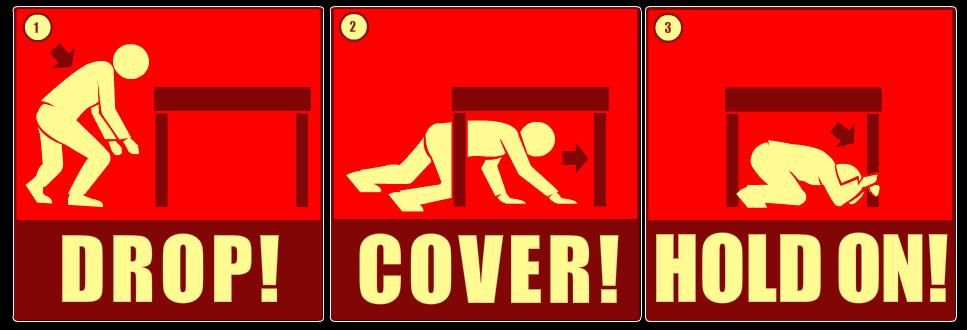
While the “Drop, Cover and Hold on”-method was the standard recommendation for a long time and is easy to learn, even by children, it unfortunately can only protect you from smaller items falling on you. During severe earthquakes in areas with weaker constructions where ceilings and walls might crash down being under a dodgy little table or pillow might do little for your survival.
The Triangle of Life Method
Contrary to the above mentioned standard practices of Drop, Cover and Hold on “, Doug Copp, director and rescue chief of American Rescue Team International, recommends an often talked down, but fairly logic method of keeping safe during an earthquake while being inside a building. Doug Copp has worked in earthquake rescue operations around the world. He saw over and over again that survivors of heavy earthquakes were always found in some sort of hollow space next to large or bulky objects like cars, furniture, fridges, etc. Therefore, it became his mission to protect people in earthquake areas from the standard recommendation "drop and cover". He says: "It is not the earthquake which kills you. Getting under a squashed desk or table kills you. You can survive by fleeing the building if you can get out the ground floor or getting into a survivable void, next to a large, bulky object".
If a ceiling or wall collapses onto the bulky object a small space next to it (like a triangle) emerges where you can survive. This method is increasingly accepted internationally especially in areas where you expect building collapses. While the Triangle of Life may save your life during a heavy earthquake, it might not protect you from smaller objects falling.
The Triangle of Life recommends to flee the building if you can get out quickly and safely. If that’s not possible, drop to the ground, get in a fetal position and lie next to (not underneath!) some sort of bulky object like a desk, sofa, fridge or even an elevator shaft (elevator shafts are one of the strongest structures in a high-rise building). If you are in a parking garage, get out of the car and lie next to it in a fetal position. If you are in bed, roll onto the floor and lie next to the bed in a fetal position.
Both methods have their pros and cons, both a reason for existence. Everyone should decide for himself which method is right or better taking the local situation and conditions into consideration..
What to do during an earthquakes, if you are outdoors
- Stay outside! Don't run back into buildings
- Move away from buildings, street lights, signs, walls!
- Watch out for all kinds of falling objects!
- Get away from ruptured power lines!
- Walk calmly to the next safety area! You will find either a sign with a big "S" or a yellow circle on the street with the capital letter "S" nearly everywhere in Peru. These areas are supposed to be safe.
- In case you are directly at the beach, seek for higher grounds. A tsunami can flood coastal areas in seconds without warning.
What to do during an earthquake, if you are in a moving vehicle
- Stop as quickly as possible and stay in the car.
- Don't stop near or under buildings, big trees, wires, on or under bridges, in tunnels...
- Once the earthquake has stopped, proceed cautiously. Watch out for debris, damaged roads and bridges.
What to do after an Earthquake?
- First of all calm down!
- Then check yourself for injuries.
- If you are unhurt, look around and help others.
- Be prepared that telecommunication services won't work.
- Ambulances and the fire brigade might not reach you due to damaged infrastructure or missing resources.
- Expect aftershocks!
- Enter buildings only after checking they are safe and with extreme caution!
- Stay away from ruptured power lines, look out for water and gas leaks!
- After destructive earthquake expect looting's.
- Listen to a radio to be informed about the general situation
- If the worst-case scenario comes true and you are trapped, stay calm, as hard as it might be, don't lighten a match or lighter, try to draw attention to you, but don't waste your energy by uncontrolled screaming; better use any object to regularly make noise and only shout when you hear voices.
We deeply hope that above detailed information prepares you well and keeps you safe during an earthquake in Peru.


